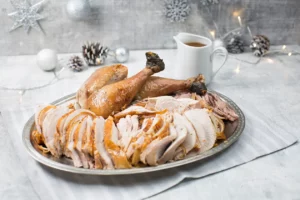The season of goodwill is the perfect time to be part of the movement towards a more sustainable future. So, if you’re dreaming of a green Christmas, check out the 16 tips below to help make a difference this year. (Adapted from World Wildlife Foundation, UK)
PRESENTS
1. Quality not quantity: Almost half of UK adults say they have received gifts they don’t want at Christmas1. When buying gifts think less but better, putting the time into picking a quality item that will last a long time. This reduces the chances of gifts going to waste and can be better for your wallet!
2. Gift an experience: Gifting an experience for your loved ones will reduce demand for physical resources that will reduce your Christmas footprint. Bring people together by gifting your time or a pre-bought experience. There are lots of options to choose from – tickets to shows, concerts or events. Gift a homemade coupon book. Make a restaurant reservation or give a gift card. Planning an experience that can be shared gives extra joy.
3. Materials Matter: Ensure wood and paper gifts are made from recycled or Forest Stewardship Council (FSC) certified materials. Avoid single-use plastic items that can’t be recycled and look for things like Fairtrade or Organic-certified food and clothing. Buying second-hand items saves on resources needed to make new products. Vintage clothes and home furnishings, and refurbished technology can make great sustainable gifts.
 4. Remove packaging: Reduce waste even further by buying gifts with little or no packaging. Sometimes shopping local can help with this, especially if you have a local refill shop. If you must use packaging, use recycled, or recyclable, materials. Avoid plastic where possible, and don’t forget your reusable bags to carry all your shopping home! If you’re more inclined to shop online, choose e-retailers that have sustainable shipping policies that won’t cost the earth.
4. Remove packaging: Reduce waste even further by buying gifts with little or no packaging. Sometimes shopping local can help with this, especially if you have a local refill shop. If you must use packaging, use recycled, or recyclable, materials. Avoid plastic where possible, and don’t forget your reusable bags to carry all your shopping home! If you’re more inclined to shop online, choose e-retailers that have sustainable shipping policies that won’t cost the earth.
5. Test your wrapping skills:Look for cards and wrapping paper made from recycled or FSC-certified paper. Avoid plastic ribbon and tape, or foil-backed and glittery wrapping paper. Choose cards that you can recycle (this means no foil or glitter!). Check out some tape-free wrapping techniques online such as furoshiki. This traditional Japanese method of using cloth to wrap and transport gifts makes for beautiful, unique, and reusable packaging.
6. Give the gift of hope: If you’re struggling for a gift idea – why not support an organization that is aligned with helping people or the planet? These are perfect gifts for nature-lovers wanting to help the environment or extend social justice.
FOOD
7. Cut your food waste: Food production is the biggest cause of tropical deforestation. Try to cut any waste by thinking ahead – be realistic about how much food you need and include leftovers in your menu planning. Instead of plastic wrap, use reusable containers, silicone pouches, or beeswax cloth covers to keep leftovers nice and fresh!
8. Eat More Plants: Eating more plant-based meals is good for you and the planet. The livestock industry generates 14.5%3 of all man-made greenhouse gas emissions. It requires huge amounts of space, water and feed. Instead, you could try a meat alternative.
9. Read food labels: Search for sustainability certifications such as RSPO-certified palm oil and MSC-certified seafood. Check where foods are produced to reduce food miles.
10. Eat seasonally: Make your shopping basket more sustainable by buying seasonal products, locally produced where possible. Doing so reduces the energy spent growing foods out of season or transporting them around the globe. Support local farmers by eating with the seasons.
DECORATIONS
11. Table Manners: Many Christmas crackers are not recyclable, and the toys inside are often made of plastic. Instead, look out for FSC-certified crackers. Reusable DIY crackers are another great option. Fill them yourself with sustainable options (like chocolates) and personalized festive favours.
Avoid single-use tablecloths and napkins. Instead, use material versions which have a longer lifecycle than their paper equivalents as you can wash and keep them. Cranberry sauce stains? No problem! Washing on a quick wash setting at lower temperatures will help to reduce your environmental footprint.
12. Think about your lights: Use LED lights on your Christmas tree, they use less energy, last longer and look just as good! Also, switch off your lights at night – it’s safer and won’t cost the earth.
13. Make your own decorations: Save yourself some money by upcycling old decorations. Or make your own using spare material around the house, like turning old paper into paperchains. If you are not crafty or don’t have the time, consider local Christmas craft markets for handmade decorations. They make a great tree ornament and/or gift!
14. Don’t forget the tree! If buying a plastic Christmas tree, make sure that you’re going to reuse it for at least 10 years. Otherwise, it would have been better to buy a living tree from a sustainable forest. If buying a real tree, make sure it’s FSC-certified. Be clear on how to dispose of your tree once the season is over. If it is potted, think about replanting it. Or get it recycled and turned into wood chips. Check your local municipal or regional website for their sustainable collection services. Purchasing a potted tree is a good solution as you can reuse it each year! Why not go a step further and rent a Christmas tree? This is where you care for a tree over the festive period and return it to be replanted for use again the next year.
SOCIALIZING
15. Dressing for the party season: This year, choose the sustainable option and try to use clothing that you already own! If you can’t find anything to wear, ask your friends or family. Or try looking around second-hand shops or using second-hand apps, for your new Christmas party outfit.
16. Reconnect to nature:  The festive season is all about spending time with friends and family. Try making one of your festive activities a walk around your local park or nature reserve. Winter is a great time to spot all sorts of over-wintering birds. Download the eBird app, which lets you identify and discover more about local species. Helping out with annual Christmas bird counts also helps scientists to track global biodiversity!
The festive season is all about spending time with friends and family. Try making one of your festive activities a walk around your local park or nature reserve. Winter is a great time to spot all sorts of over-wintering birds. Download the eBird app, which lets you identify and discover more about local species. Helping out with annual Christmas bird counts also helps scientists to track global biodiversity!


